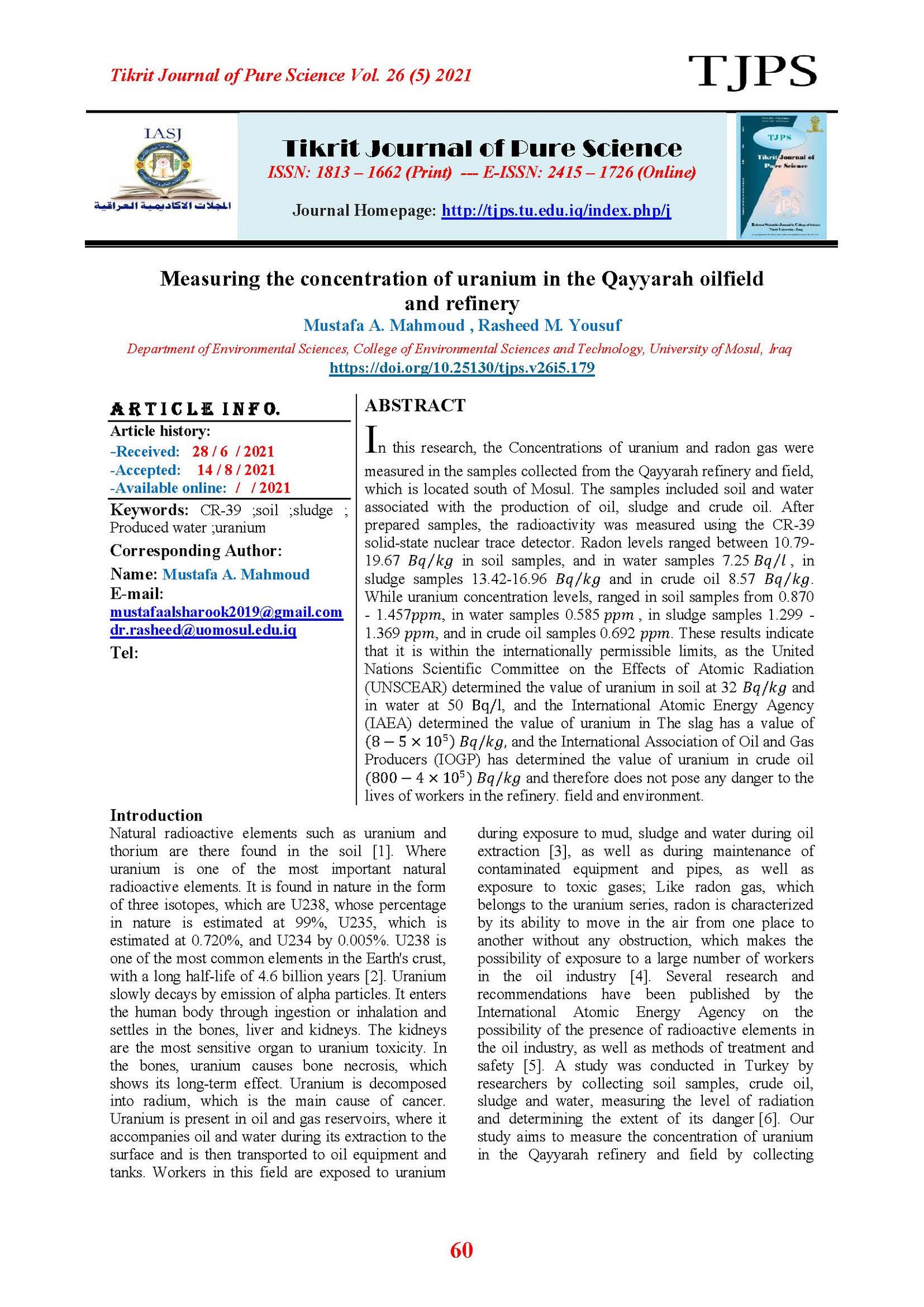Measuring the concentration of uranium in the Qayyarah oilfield and refinery
Main Article Content
Abstract
In this research, the Concentrations of uranium and radon gas were measured in the samples collected from the Qayyarah refinery and field, which is located south of Mosul. The samples included soil and water associated with the production of oil, sludge and crude oil. After prepared samples, the radioactivity was measured using the CR-39 solid-state nuclear trace detector. Radon levels ranged between 10.79-19.67 in soil samples, and in water samples 7.25 , in sludge samples 13.42-16.96 and in crude oil 8.57 . While uranium concentration levels, ranged in soil samples from 0.870 - 1.457 , in water samples 0.585 , in sludge samples 1.299 - 1.369 , and in crude oil samples 0.692 . These results indicate that it is within the internationally permissible limits, as the United Nations Scientific Committee on the Effects of Atomic Radiation (UNSCEAR) determined the value of uranium in soil at 32 and in water at 50 , and the International Atomic Energy Agency (IAEA) determined the value of uranium in The slag has a value of and the International Association of Oil and Gas Producers (IOGP) has determined the value of uranium in crude oil and therefore does not pose any danger to the lives of workers in the refinery. field and environment.
Article Details

This work is licensed under a Creative Commons Attribution 4.0 International License.
Tikrit Journal of Pure Science is licensed under the Creative Commons Attribution 4.0 International License, which allows users to copy, create extracts, abstracts, and new works from the article, alter and revise the article, and make commercial use of the article (including reuse and/or resale of the article by commercial entities), provided the user gives appropriate credit (with a link to the formal publication through the relevant DOI), provides a link to the license, indicates if changes were made, and the licensor is not represented as endorsing the use made of the work. The authors hold the copyright for their published work on the Tikrit J. Pure Sci. website, while Tikrit J. Pure Sci. is responsible for appreciate citation of their work, which is released under CC-BY-4.0, enabling the unrestricted use, distribution, and reproduction of an article in any medium, provided that the original work is properly cited.
References
[1] Hazou, E., and Patchali, T. E. (2021). Assessment of radiological hazards in the phosphate mining area of Kpogamé, Togo. Case Studies in Chemical and Environmental Engineering, 3, 100077.
[2] Shanshal, M. A. A. J.and Shehab, O. H., and SaadoonFaris, S. (2015). Determination of uranium in soil samples from Al-Fallujah city by using of Solid State Nuclear Track Detectors (CR-39). Journal of university of Anbar for Pure science, 9(3).
[3] Attallah, M. F. and Hamed, M. M.and El Afifi, E. M., and Aly, H. F. (2015). Removal of 226Ra and 228Ra from TENORM sludge waste using surfactants solutions. Journal of environmental radioactivity, 139, 78-84.
[4] Awwad, N. S.et al. (2015). Overview about different approaches of chemical treatment of NORM and TE-NORM produced from oil exploitation. Advances in Petrochemicals.
[5] IAEA,.(2003). "Radiation Protection and the Management of Radioactive Waste," IAEA Technical Report Series, Vienna, No. 34 .
[6] Parmaksız,A. et al . (2015). Measurement of enhanced radium isotopes in oil production wastes in Turkey. Journal of environmental radioactivity, 141, 82-89.
[7] Saeed, S. H. and Hassan, S. Y. (2015). Determination of Radon, Uranium and Other Radioactive Isotopes' Concentration in Different
Types of Natural Water in Nenava Governorate. Jordan Journal of PhysicS, 8(4), 227-244.
[8] M Al-Badrani, M. (2006). Determination of Radioactive Contamination of Plant Fertilizers Using CR-39. Rafidain Journal of Science, 17(6), 1-10.
[9] H Ali, A., K Mh, A., and I Hassan, H. (2014). Determination of the Background Radiation Level in Mosul University Campus Using Multiple Technologies. Rafidain Journal of Science, 25(5), 86-100.
[10] UNSCEAR.(2008). "Health effects due to radiation from the Chernobyl accident Draft," report A/AC," 82/R.673, 1–220.220, United Nations Scientific Committee on the Effects of Atomic Radiation.
[11] UNSCEAR,.(1994) " United Nations Committee on the Effect of Atomic Radiation," Sources and NCRP. Exposure of the population in the United States and Canada from natural background radiation, NCRP report no.94, National Council on Radiation Protection and Measurement.
[12] OPG, (2008). "Guidelines for the management of Naturally Occuring Radioactive Material (NORM) in the oil and gas industry,," International Association of Oil & Gas Producers. Report No.412.
